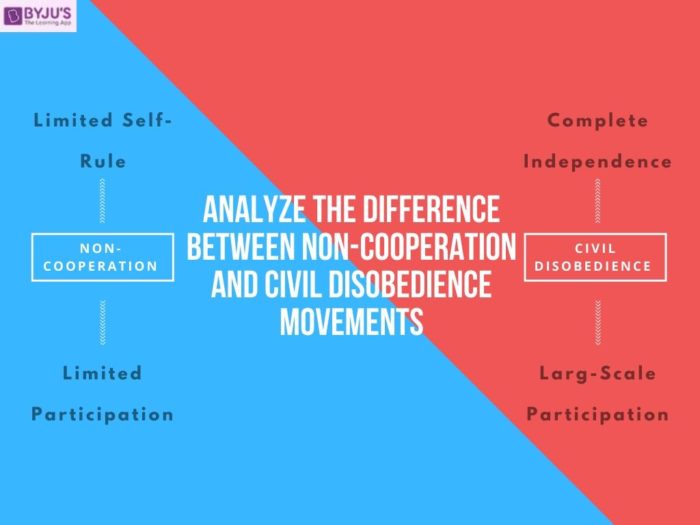The non-cooperation and the civil disobedience movements were landmark moments during India’s independence struggle. Both played a key role in ensuring that India’s independence from British rule was guaranteed on 15th August 1947, and both were the brainchild of Mahatma Gandhi.
Although both the movements had the complete independence of India in mind, how they were executed and the methodology employed was remarkably different.
The non-cooperation movement sought the attention of the British colonial authorities by bringing the government to a standstill.
The civil disobedience movement sought to paralyse the government by breaking specific rules and administration.

This article will further highlight the difference between the non-cooperation movement and the civil-disobedience movement for the IAS Exam
The differences between the non-cooperation movement and the civil-disobedience movement are given in the table below:
Differences between the Non-cooperation and Civil-Disobedience Movements
| Non-cooperation |
Civil-Disobedience |
| It was launched on September 4th, 1920 and ended on 4th February 1922. | It started on March 12, 1930, through the launch of the Salt Satyagraha. |
| The Non-Cooperation Movement sought to bring the working of the government to a standstill by not cooperating with the administration. | The Civil Disobedience Movement was an attempt at paralysing the administration by breaking some specific rules and regulations. |
| There was extensive scale participation of the Muslim working class in the Non-Cooperation movement. | The Civil-Disobedience movement saw less participation from the Muslim community due to the policy of divide and rule by the British and the communal propaganda of the Muslim League and the Hindu Mahasabha. |
| The non-cooperation movement was geographically confined to certain parts of India. | The civil disobedience movement saw widespread geographical coverage and mass participation in comparison to the non-cooperation movement. |
| The movement was called off in 1922 due to the Chauri-Chaura incident (Occurred on Feb 4th, 1922). | The movement was withdrawn after the signing of the Gandhi-Irwin pact. |
The Non-cooperation and civil disobedience movements are covered under the Modern Indian History segment of the UPSC Exams. The following links will help candidates with the segment:
- NCERT Modern Indian History Notes for UPSC
- Revolutionaries in the Indian Freedom Movement
- Quit India Movement
- Important Indian Freedom Fighters and their Contributions
- Difference Between Moderates and Extremists
- Difference Between Governor-General and Viceroy
Difference Between the Non-Cooperation Movement and Civil Disobedience Movement – Download PDF Here
Aspirants can find more Difference Between Articles by visiting the linked page.
FAQ about Non-Cooperation Movement and Civil Disobedience Movement
How did the non-cooperation movement begin?
What are the demands of Gandhi during the Civil Disobedience Movement?
Although there are so many differences, are there any similarities in Non – Cooperation and Civil Disobedience Movements?
When was Non – Cooperation Movement started?
In which year was the Civil Disobedience Movement initiated?
How did the Civil Disobedience Movement and Non – Cooperation Movement end?
Who were the significant participants of the Non-Cooperation movement?
Who were the participants of the Civil Disobedience Movement?
Candidates can find the general pattern of the UPSC Exams by visiting the UPSC Syllabus page. For more articles and exam-related preparation materials, refer to the links given in the table below:
Related Links

your notes are really crisp and helpful in revision, thanks for your efforts